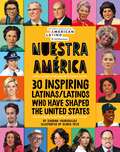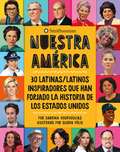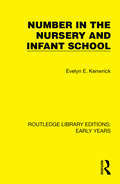- Table View
- List View
NTS Assessments Year 5 Maths Autumn Paper 1: Arithmetic (PDF)
by Trevor DixonNTS Assessments Year 5 Maths Autumn Paper 1: Arithmetic.
NTS Assessments Year 5 Maths Autumn Papers 2 & 3: Reasoning (PDF)
by Trevor DixonNTS Assessments Year 5 Maths Autumn Papers 2 & 3: Reasoning.
NTS English Year 1 Spring Paper 2: Grammar and Spelling
by Siobhan SkeffingtonNTS English Year 1 Spring Paper 2: Grammar and Spelling
NTS Maths Year 5 Spring Paper 1: Arithmetic
by Trevor DixonNTS Maths Year 5 Spring Paper 1: Arithmetic
NTS Maths Year 5 Spring Papers 2 and 3: Reasoning
by TrevNTS Maths Year 5 Spring Papers 2 and 3: Reasoning
NTS Reading Year 1 Spring Paper 1: Reading
by Siobhan SkeffingtonNTS Reading Year 1 Spring Paper 1: Reading
NTS Reading Year 5 Spring Reading Answer Booklet
by Marie LallawayNTS Reading Year 5 Spring Reading Answer Booklet
The Nuclear Imperative: A Critical Look at the Approaching Energy Crisis (Topics in Safety, Risk, Reliability and Quality #11)
by Jeff W. EerkensIn this global wake-up call, nuclear physicist Jeff Eerkens explores remedies for the impending energy crisis, when oil and natural gas are depleted. The Nuclear Imperative demonstrates that solar, wind, and biomass power are incapable of supplying the enormous quantities of electricity and heat needed for manufacturing portable synthetic fuels to replace our current use of fossil fuels. It offers a fresh look at uranium-produced energy as the optimal affordable solution.
Nuestra América: 30 Inspiring Latinas/Latinos Who Have Shaped the United States
by Sabrina VourvouliasCelebrate 30 influential Latinas/Latinos/Latinxs in U.S. history with Nuestra América, a fully-illustrated anthology from the Smithsonian Latino Center. Nuestra América highlights the inspiring stories of thirty Latina/o/xs throughout history and their incredible contributions to the cultural, social, and political character of the United States. The stories in this book cover each figure's cultural background, childhood, and the challenges and opportunities they met in pursuit of their goals. A glossary of terms and discussion question-filled reading guide, created by the Smithsonian Latino Center, encourage further research and exploration. Twenty-three of the stories featured in this anthology will also be included in the future Molina Family Latino Gallery, the first national gallery dedicated to Latina/o/xs at the Smithsonian.This book is a must-have for teachers looking to create a more inclusive curriculum, Latina/o/x youth who need to see themselves represented as an important part of the American story, and all parents who want their kids to have a better understanding of American history. Featuring beautiful portraits by Gloria Félix, this is a book that children (and adults) will page through and learn from again and again.Nuestra América profiles the following notable figures: Sylvia Acevedo, Luis Álvarez, Pura Belpré, Martha E. Bernal, Julia de Burgos, César Chávez, Sandra Cisneros, Roberto Clemente, Celia Cruz, Olga E. Custodio, Óscar de la Renta, Jaime Escalante, Macario García, Emma González, Laurie Hernández, Juan Felipe Herrera, Dolores Huerta, Jennifer Lopez, Xiuhtezcatl Martínez, Sylvia Méndez, Lin-Manuel Miranda, C. David Molina, Rita Moreno, Ellen Ochoa, Jorge Ramos, Sylvia Rivera, María Elena Salinas, Sonia Sotomayor, Dara Torres, and Robert Unanue.
Nuestra Am¿rica: 30 latinas/latinos inspiradores que han forjado la historia de Los Estados Unidos
by Sabrina VourvouliasSe celebran 30 latinas y latinos influyentes en la historia estadounidense con Nuestra América, una antología completamente ilustrada del Centro Latino Smithsonian.Nuestra América resalta las historias inspiradoras de treinta latinas y latinos a lo largo de la historia y sus muchas contribuciones al carácter cultural, social y político de los Estados Unidos.Las historias de cada figura dentro del libro relatan su herencia cultural, su niñez y los retos y oportunidades con las cuales se encontraron al perseguir sus metas. Un glosario de términos y una guía de lectura, creada por el Centro Latino Smithsonian, promueven más investigaciones y exploración. Veintitrés de las historias presentadas en esta antología serán también incluidas en la futura Galería Latina de la Familia Molina, la primera galería nacional dedicada a los latinos en el Smithsonian.Este libro es imprescindible para maestros buscando crear un currículo más inclusivo, jóvenes latinos que necesitan verse representados como una parte importante de la historia estadounidense y todo padre queriendo que sus hijos tengan mejor entendimiento de la historia de los Estados Unidos. Con bellos retratos por Gloria Félix, jóvenes (y adultos) seguirán hojeando y aprendiendo de Nuestra América una y otra vez.Nuestra América destaca las siguientes figuras notables:Sylvia Acevedo, Luis Álvarez, Pura Belpré, Martha E. Bernal, Julia de Burgos, César Chávez, Sandra Cisneros, Roberto Clemente, Celia Cruz, Olga E. Custodio, Óscar de la Renta, Jaime Escalante, Macario García, Emma González, Laurie Hernández, Juan Felipe Herrera, Dolores Huerta, Jennifer Lopez, Xiuhtezcatl Martínez, Sylvia Méndez, Lin-Manuel Miranda, C. David Molina, Rita Moreno, Ellen Ochoa, Jorge Ramos, Sylvia Rivera, María Elena Salinas, Sonia Sotomayor, Dara Torres y Robert Unanue.
Number: Activities for Children with Mathematical Learning Difficulties
by Mel LeverFirst Published in 2003. Routledge is an imprint of Taylor & Francis, an informa company.
Number: Activities for Children with Mathematical Learning Difficulties
by Mel LeverFirst Published in 2003. Routledge is an imprint of Taylor & Francis, an informa company.
Number Fun: Phase 1 (PDF) (Big Cat Phonics for Little Wandle Letters and Sounds Revised)
by Emily Guille-Marrett Charlotte Raby Illustrated by Laura Gonzales Prepared for publication by Collins Big CatNumber in the Nursery and Infant School (Routledge Library Editions: Early Years)
by Evelyn E. KenwrickOriginally published in 1937, Number in the Nursery and Infant School surveys the teachings of Froebel, Montessori and Dewey, the prevalent theories in education at the time, and takes elements from each in order to outline a new method. The author was closely associated with infant-school work over a number of years. She also trained teachers for that purpose, carefully observing the results of different methods of teaching. The method described was in full accord with modern psychological theory of the time, today it can be read and enjoyed in its historical context.
Number in the Nursery and Infant School (Routledge Library Editions: Early Years)
by Evelyn E. KenwrickOriginally published in 1937, Number in the Nursery and Infant School surveys the teachings of Froebel, Montessori and Dewey, the prevalent theories in education at the time, and takes elements from each in order to outline a new method. The author was closely associated with infant-school work over a number of years. She also trained teachers for that purpose, carefully observing the results of different methods of teaching. The method described was in full accord with modern psychological theory of the time, today it can be read and enjoyed in its historical context.
Number, Pattern And Calculating 1: Implementation Guide 1
by Ruth Atkinson Romey Tacon Tony WingThe Numicon Number, Pattern and Calculating 1 Teaching Pack comprises a Teaching Resource Handbook and an Implementation Guide, providing the core materials you need to start teaching children aged 5 to 6. The Teaching Resource Handbook provides step-by-step activities for developing children's understanding of pattern, algebra, number and calculating. With a great emphasis on problem-solving through real-world contexts and practical planning and assessment guidance, the Teaching Resource Handbookwill support you with developing children's mathematical understanding using Numicon. Accompanied with editable planning and printable photocopy masters, you can personalise to suit the needs of your children. The Implementation Guide offers guidance on what Numicon is, gives advice on how best to implement Numicon in your school and describes the Key Mathematical Ideas that underpin work within this year. With information on the theory behind Numicon, this guide will inspire you in building a securefuture in mathematics for all children.
Number, Pattern And Calculating 1: Teaching Resource Handbook 1
by Ruth Atkinson Romey Tacon Tony WingThe Numicon Number, Pattern and Calculating 1 Teaching Pack comprises a Teaching Resource Handbook and an Implementation Guide, providing the core materials you need to start teaching children aged 5 to 6. The Teaching Resource Handbook provides step-by-step activities for developing children's understanding of pattern, algebra, number and calculating. With a great emphasis on problem-solving through real-world contexts and practical planning and assessment guidance, the Teaching Resource Handbookwill support you with developing children's mathematical understanding using Numicon. Accompanied with editable planning and printable photocopy masters, you can personalise to suit the needs of your children. The Implementation Guide offers guidance on what Numicon is, gives advice on how best to implement Numicon in your school and describes the Key Mathematical Ideas that underpin work within this year. With information on the theory behind Numicon, this guide will inspire you in building a securefuture in mathematics for all children.
Number, Pattern and Calculating: Teaching Resource Handbook 6 (PDF)
by Jayne CamplingNumicon is a proven approach for teaching and learning maths that builds deep understanding and engagement. Through active investigation with problem-solving at its heart and supported by structured apparatus, children reason and communicate mathematically with confidence.
Number Sense Routines: Building Numerical Literacy Every Day in Grades K-3
by Jessica ShumwayIn this groundbreaking and highly practical book,Number Sense Routines: Building Numerical Literacy Every Day in Grades K-3, author Jessica Shumway proposes that all children have innate number sense which can be developed through daily exercise. Shumway createda series of math routines designed to help young students strengthen and build their facility with numbers. These quick 5, 10, or 15 minute exercises are easy to implement as an add-on to any elementary math curriculum. Understanding Number Sense: Students with strong number sense understand numbers, how to subitize, relationships among numbers, and number systems. They make reasonable estimates, compute fluently, use reasoning strategies, and use visual models to solve problems. Number Sense Routines supports the early learner by instilling the importance of daily warm-ups and explains how they benefit developing math minds for long-term learning. Real Classroom Examples: Shumway compiled her classroom observations from around the country. She includes conversations among students who practice number sense routines to illustrate them in action, how children's number sense develops with daily use, and math strategies students learn as they develop their numerical literacy through self-paced practice. Assessment Strategies: Number Sense Routines demonstrates the importance of listening to your students and knowing what to look for. Teachers will gain a deeper understanding of the underlying math skills and strategies students learn as they develop numerical literacy. Shumway writes, As you read, you will step into various classrooms and listen in on students' conversations, which I hope will give you insight into the power of number sense routines and the impact they have on students' number sense development. My hope is that going into the classroom, into students' conversations, and into their thought processes, you will come away with new ideas and tools to use in your own classroom.
Number Sense Routines: Building Mathematical Understanding Every Day in Grades 3-5
by Jessica ShumwayFollowing up her' best-selling book, Number Sense Routines: Building Numerical Literacy Every Day in Grades K-3, Jessica Shumway turns her focus to upper elementary classrooms. Number Sense Routines: Developing Mathematical Understanding Every Day in Grades 3-5 is about tapping into every child' s innate number sense and providing daily, connected experiences that are responsive to children's learning needs. Consistent, Daily Routines Work:' Adaptable to any curriculum, Shumway' s 5, 10, or 15 minute warm-up routines are an easy and effective way to build and solidify students' number sense foundations as a supplement to any program Planning and Facilitating Your Classroom:' No matter how familiar the routine, Shumway provides insight on how to keep daily warm-ups fresh. She reveals careful thinking and planning that goes into each routine and offers detailed vignettes and dialogues of how they unfold in real classrooms Assessment Strategies:' As students engage in the process, each routine becomes an exciting opportunity to gain insight into where they are in their understanding and help students articulate their mathematical thinking Identify Big Ideas: Not only will these math routines help develop students' mathematical understanding as they move towards using standard algorithms, but teachers will learn to better recognize the big ideas that emerge in discussions, how to encourage important strategies based in number sense, and how to facilitate conversations on key mathematical concepts. ' 'These routines may appear in other places, [but] I have never seen them written in such detail and with so many variations.. . .. Although she makes what she does sound easy, we all know that teaching math well is anything but easy. It is challenging and complex. Unpacking what students are saying, helping them make connections not only to the math but to each other's ideas, while simultaneously recording their ideas using mathematical models, visuals, or equations is no easy task. Jessica provides wonderful visuals, examples of student work, and so much more to help educators develop the tools they need to improve their practice and in so doing improve student learning. ' ' ' ' ' ' ' ' ' ' ' ' ' ' ' ' ' ' ' ' ' ' ' ' ' ' ' ' ' ' ' ' ' ' ' ' ' ' ' ' ' ' ' ' ' ' ' ' ' ' ' ' ' ' ' ' ' ' ' ' ' ' ' ' ' ' ' ' ' ' ' ' ' ' ' ' ' ' ' ' ' ' ' ' ' ' ' ' ' ' ' ' ' ' ' ' ' ' ' ' ' ' ' ' ' ' ' ' ' ' ' ' ' ' ' ' ' ' ' ' ' – From the Foreword by math coach and consultant Lucy West










